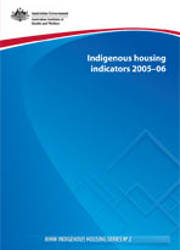Table of contents
- Preliminary material (169KB PDF)
- Half title and verso pages
- Title page and verso
- Contents
- Acknowledgments
- Abbreviations
- Symbols used
- Summary
- Sections (469K PDF)
- Introduction
- The National Reporting Framework
- Quantitative indicators
- Indicator 1. Total number of dwellings targeted to Indigenous people
- Indicator 2. Proportion of improvised dwellings
- Indicator 3. Proportion of dwellings needing major repairs
- Indicator 4. Proportion of dwellings needing replacement
- Indicator 6. Proportion of communities not connected to (a) water (b) sewerage (c) electricity
- Indicator 7. Proportion of dwellings not connected to (a) water (b) sewerage (c) electricity
- Indicator 8. Proportion of dwellings meeting the 11 critical FHBH healthy living practices
- Indicator 9. Average weekly rent collected
- Indicator 10. Rent collection rate
- Indicator 11. Total amount spent on maintenance each year
- Indicator 12. Average amount spent on maintenance each year
- Indicator 13. Maintenance expenditure as a proportion of rent collected
- Indicator 14. Recurrent to capital expenditure ratio
- Indicator 15. Direct cost per unit
- Indicator 16. Occupancy rates
- Indicator 17. Turnaround time
- Indicator 18. Proportion of Indigenous households by tenure type
- Indicator 19. Proportion of households accessing mainstream housing services that are Indigenous
- Indicator 20. Proportion of Indigenous people who are homeless
- Indicator 21. Total and average number of additional bedrooms required
- Indicator 22. Proportion of Indigenous households that are overcrowded
- Indicator 23. Proportion of households paying more than 25% of income in rent
- Indicator 25. Number of Indigenous community housing organisations
- Indicator 26. Proportion of ICHOs that have a housing management plan
- Indicator 28. Proportion of Indigenous employees in ICHOs who have completed accredited training
- Indicator 29. Proportion of Indigenous employees in ICHOs who are undertaking accredited training
- Indicator 30. Proportion of people employed in housing management who are Indigenous
- Indicator 34. Proportion of clients whose needs were met in relation to the (a) amenity (b) location of their dwelling
- Indicator 35. Proportion of clients satisfied with quality of the service provided
- Indicator 36. Proportion of indicators (not Census or CHINS) on which jurisdictions could report
- Qualitative indicators
- Indicator 5. Mechanisms to ensure that new houses and upgrades meet national minimum standards
- Indicator 24. Allocation of resources on the basis of need
- Indicator 27. What jurisdictions are doing to assist ICHOs in developing and implementing housing management plans
- Indicator 31. Strategies and outcomes to increase Indigenous employment in housing services
- Indicator 32. Mechanisms for Indigenous input to planning, decision making and delivery of services
- Indicator 33. Coordination of housing and other services
- Introduction
- End matter (238KB PDF)
- Appendixes
- Appendix A: NRF summary table
- Appendix B: NRF indicators by BBF outcome area
- Appendix C: Australian Government Questionnaire
- List of tables
- References
- Appendixes



